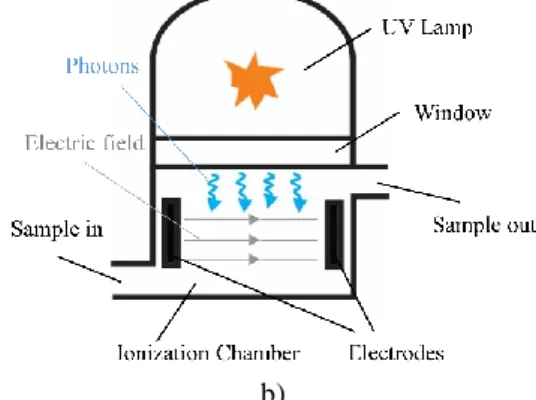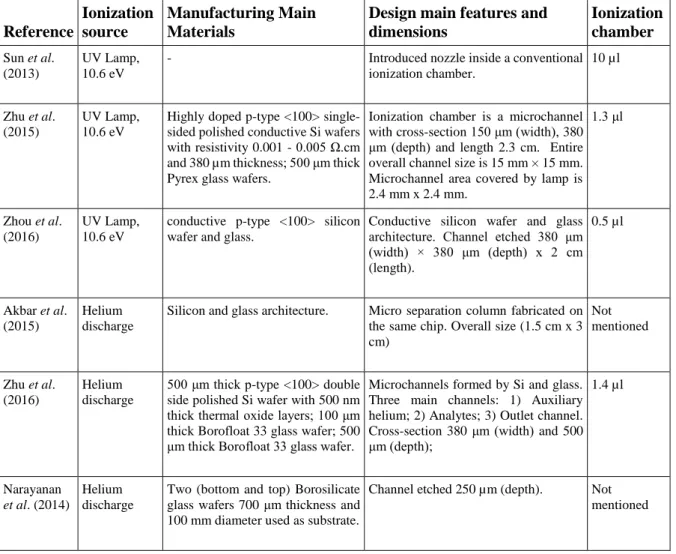HAL Id: hal-02385957
https://hal.archives-ouvertes.fr/hal-02385957
Submitted on 29 Nov 2019
HAL is a multi-disciplinary open access archive for the deposit and dissemination of sci-entific research documents, whether they are pub-lished or not. The documents may come from teaching and research institutions in France or abroad, or from public or private research centers.
L’archive ouverte pluridisciplinaire HAL, est destinée au dépôt et à la diffusion de documents scientifiques de niveau recherche, publiés ou non, émanant des établissements d’enseignement et de recherche français ou étrangers, des laboratoires publics ou privés.
VOLATILE ORGANIC COMPOUNDS: STATE OF
THE ART AND FUTURE STUDIES
Gustavo Coelho Rezende, David Newport, Stéphane Le Calvé
To cite this version:
Gustavo Coelho Rezende, David Newport, Stéphane Le Calvé. MICRO PHOTO IONIZATION DE-TECTOR FOR VOLATILE ORGANIC COMPOUNDS: STATE OF THE ART AND FUTURE STUDIES. 3rd MIGRATE Workshop, Jun 2018, Bastia, France. �hal-02385957�
1
MIGRATE2018:210246
MICRO PHOTO IONIZATION DETECTOR FOR VOLATILE
ORGANIC COMPOUNDS: STATE OF THE ART AND FUTURE
STUDIES
Gustavo Coelho Rezende*
1,3,4, David Newport
1, Stéphane Le Calvé
2,31Univeristy of Limerick, V94 T9PX, Castletroy, Limerick, Ireland
gustavo.coelho@ul.ie, david.newport@ul.ie
2Université de Strasbourg, 25 Rue Becquerel, Strasbourg, France
slecalve@unistra.fr
3In’Air Solutions, 1 rue Blessig, 67000 Strasbourg, France 4Karlsruhe Institute of Technology, Karlsruhe, Germany
KEY WORDS
Photo ionization detector, Volatile Organic Compounds, Microfabrication
ABSTRACT
Volatile Organic Compounds (VOCs) are a class of carbon-containing chemicals that have a high vapor pressure at ambient temperature. Typical indoor sources of VOCs are varnishes, paints, solvents, cleaning materials, etc. In addition, outdoor sources such as automobile and industrial waste also contribute to both indoor and indoor VOC pollution [1]. Many VOCs are harmful to humans, including benzene, which is carcinogenic and has no safe recommended level of exposure [2], [3]. The European Commission established, with effect from 2010, a regulation for benzene exposure at a maximum limit of 5 µg/m³ (1.6 ppb) [4]. In addition, within the European Union, regulations and guidelines are established to maintain a healthy indoor air quality [4], [5].
Gas Chromatographs (GC), which can separate, identify and quantify different chemicals, can be used to detect airborne VOCs. However, commercial GCs are still heavy, bulky, slow, lab-based equipment. The development of a transportable, sensitive and fast GC analysis can improve gas evaluation and device miniaturization can contribute to this achievement. One of the main components of a GC is the detector, responsible for quantifying the chemicals. This work is centered on a GC detector, namely the photo ionization detector (PID). The objective is to report the state of the art in PID miniaturization with emphasis on its fabrication processes and suggest future studies and designs as solutions for further development of µPIDs.
PIDs can be classified according to the ionization source. When the ionization source is unseparated from the ionization chamber by a window, the ionization source is usually a discharge on a noble gas such as Helium, and is called discharge photo ionization detector (D-PID); or when the ionization source has no fluidic connection to the ionization chamber, which is the lamp photo ionization detector (L-PID). Fig. 1 shows the basic elements of two types of photo ionization detectors. In both devices, a gas sample containing the chemicals flows through the ionization chamber, where photons emitted by the ionization source reach the sample molecules. As a general rule, if the ionization energy of the photon is greater than the ionization potential of the molecule, ionization occurs. The electrodes establish then an electric field in the ionization chamber where the ionized molecules generate an ionization current
2
proportional to their concentration. Based on an external calibration, the electrical signal can be translated into a VOC concentration.
Commercial PIDs have dimensions of the order of 10 mm, which are already small compared to overall commercial GCs sizes, and the ionization chamber of commercial PIDs have volume ranging from 100 µl to 200 µl. Recently, PIDs with ionization chambers 100 times smaller (volume close to 1 µl) were developed, where the reductions in ionization chamber size were achieved with microfabrication techniques using photolithography and etching [6]–[11]. The miniaturization of PIDs is favorable to improve both PID and GC performance. Small ionization chamber size allows for faster response times at a given flow rate. Diminishing ionization chamber also reduces carrier gas consumption from the gas chromatograph, which enables greater autonomy of the GC in field use. At the detector performance level, a lower ionization chamber volume facilitates a smaller gap between the electrodes, improving ion and collection efficiency [7]. There is also the possibility of avoiding remixing of elements eluting from the separation column. Miniaturized PIDs developed recently are presented in the two paragraphs below and in Tab. 1.
For PIDs using a UV Lamp as the ionization source, the first considerable reduction of ionization chamber volume was achieved by Sun et al. (2013) [6], where they introduced a nozzle inside a conventional ionization chamber, yielding a 10 µl volume chamber. Another important feature of this design was placing the collection electrode close to the UV lamp window, in a region that optimizes collection of ions. Also the accelerating electrode was placed in a groove in the nozzle, which protected it against direct UV radiation. Recently, Zhu et al. (2014) [7] used photolithography and microfabrication to make a L-µPID on a conductive silicon wafer and glass architecture. Their device consisted in a microfluidic channel in Si etched with deep reactive ion etching (DRIE) and the electrodes were the Si walls of the channels, a commercial UV lamp with 10.6 eV was mounted on top of the channel and the final ionization chamber volume was 1.3 μl. Zhou et al. (2016) [8] fabricated another L-µPID using conductive silicon wafer and glass. Their design had a 2 cm long straight channel with cross section etched by DRIE, resulting in an estimated 0.5 µl ionization chamber volume.
Microfabrication techniques are also used to make discharge PIDs. [9] Akbar et al. (2015) used silicon-glass to fabricate a D-µPID where the channels and chambers of the detector were etched with DRIE. His device was also integrated with a separation column on a single chip. The detector electrodes were made with e-beam evaporation of 700 nm/40 nm thick Ti/Au metal stack. Also using silicon-glass architecture Zhu et al. (2016) [10] designed a D-µPID on a straight channel where the Si wafer was diced and wet etched. The glass wafers were also diced and the Si/glass parts were bonded together to form the three microchannels of the device with estimated ionization chamber volume of 1.4 μl. In a slightly different approach, Narayanan et al. (2016) [11] developed a D-µPID using two 700 µm thickness Borosilicate glass wafers. After wet etching the main fluidic parts and creating the electrodes, the two parts were diced and bonded with epoxy.
a) b)
3
Table 1: Microfabricated PIDs manufacturing and design properties.
Reference
Ionization source
Manufacturing Main Materials
Design main features and dimensions Ionization chamber Sun et al. (2013) UV Lamp, 10.6 eV
- Introduced nozzle inside a conventional
ionization chamber. 10 µl Zhu et al. (2015) UV Lamp, 10.6 eV
Highly doped p-type <100> single-sided polished conductive Si wafers with resistivity 0.001 - 0.005 Ω.cm and 380 µm thickness; 500 μm thick Pyrex glass wafers.
Ionization chamber is a microchannel with cross-section 150 μm (width), 380 μm (depth) and length 2.3 cm. Entire overall channel size is 15 mm × 15 mm. Microchannel area covered by lamp is 2.4 mm x 2.4 mm. 1.3 μl Zhou et al. (2016) UV Lamp, 10.6 eV
conductive p-type <100> silicon wafer and glass.
Conductive silicon wafer and glass architecture. Channel etched 380 μm (width) × 380 μm (depth) x 2 cm (length). 0.5 µl Akbar et al. (2015) Helium discharge
Silicon and glass architecture. Micro separation column fabricated on
the same chip. Overall size (1.5 cm x 3 cm) Not mentioned Zhu et al. (2016) Helium discharge
500 μm thick p-type <100> double side polished Si wafer with 500 nm thick thermal oxide layers; 100 μm thick Borofloat 33 glass wafer; 500 μm thick Borofloat 33 glass wafer.
Microchannels formed by Si and glass. Three main channels: 1) Auxiliary helium; 2) Analytes; 3) Outlet channel. Cross-section 380 μm (width) and 500 μm (depth); 1.4 µl Narayanan et al. (2014) Helium discharge
Two (bottom and top) Borosilicate glass wafers 700 μm thickness and 100 mm diameter used as substrate.
Channel etched 250 µm (depth). Not
mentioned
Most of the recently published literature on PIDs mentioned here show important features in the miniaturization of the devices, such as low ionization chamber volume, a shortened distance between electrodes and low energy consumption. These characteristic are relevant to improve the PID and GC performance. Despite that, the field of miniaturized PIDs have multiple aspects to improve in terms of knowledge and design. For example, D-PIDs still suffer from high noise and L-PIDs are still using commercial PIDs lamps. Also, the direct incidence of photons on the electrodes of microfabricated PIDs are still a problem, since it causes photoelectric effect, which depletes minimum detectable limit. Most miniaturized PIDs are fabricated using etching and lithography, which are expensive manufacturing techniques. Future designs should be able to have cheap prototypes for testing how µPIDs parameters influence their performance, such as flow, pressure, temperature, rarefaction, carrier gas, construction materials, etc. Our team is working to develop a design to address those needs.
4 Acknowledgements
This ITN Research Project is supported by European Community H2020 Framework under the Grant Agreement No. 643095
References and Citations
[1] L. A. Wallace, E. Pellizzari, B. Leaderer, H. Zelon, and L. Sheldon, “Emissions of volatile organic compounds from building materials and consumer products,” Atmos. Environ., vol. 21, no. 2, pp. 385–393, 1987.
[2] WHO, “Air quality guidelines for Europe,” 2000.
[3] WHO, “WHO Guidelines for Indoor Air Quality: Selected Pollutants,” 2010.
[4] European Comission, “DIRECTIVE 2000/69/EC OF THE EUROPEAN PARLIAMENT AND OF THE COUNCIL of 16 November 2000 relating to limit values for benzene and carbon monoxide in ambient air.,” Official Journal of the European Communities. 2000.
[5] du D. D. des T. et du L. Ministère de l’Ecologie, “Décret no 2011-1727 du 2 décembre 2011 relatif aux valeurs-guides pour l’air intérieur pour le formaldéhyde et le benzène,” Journal Officiel de la République Française. 2011.
[6] J. Sun, F. Guan, D. Cui, X. Chen, L. Zhang, and J. Chen, “An improved photoionization detector with a micro gas chromatography column for portable rapid gas chromatography system,” Sensors Actuators, B Chem., vol. 188, no. Supplement C, pp. 513–518, 2013.
[7] H. Zhu et al., “Flow-through microfluidic photoionization detectors for rapid and highly sensitive vapor detection,” Lab Chip, vol. 15, no. 14, pp. 3021–3029, 2015.
[8] M. Zhou, J. Lee, H. Zhu, R. Nidetz, K. Kurabayashi, and X. Fan, “A fully automated portable gas chromatography system for sensitive and rapid quantification of volatile organic compounds in water,” RSC Adv., vol. 6, no. 55, pp. 49416–49424, 2016.
[9] M. Akbar, H. Shakeel, and M. Agah, “GC-on-chip: integrated column and photoionization detector,” Lab Chip, vol. 15, no. 7, pp. 1748–1758, 2015.
[10] H. Zhu, M. Zhou, J. Lee, R. Nidetz, K. Kurabayashi, and X. Fan, “Low-Power Miniaturized Helium Dielectric Barrier Discharge Photoionization Detectors for Highly Sensitive Vapor Detection,” Anal. Chem., vol. 88, no. 17, pp. 8780–8786, 2016.
[11] S. Narayanan, G. Rice, and M. Agah, “A micro-discharge photoionization detector for micro-gas chromatography,” Microchim. Acta, vol. 181, no. 5–6, pp. 493–499, 2014.

